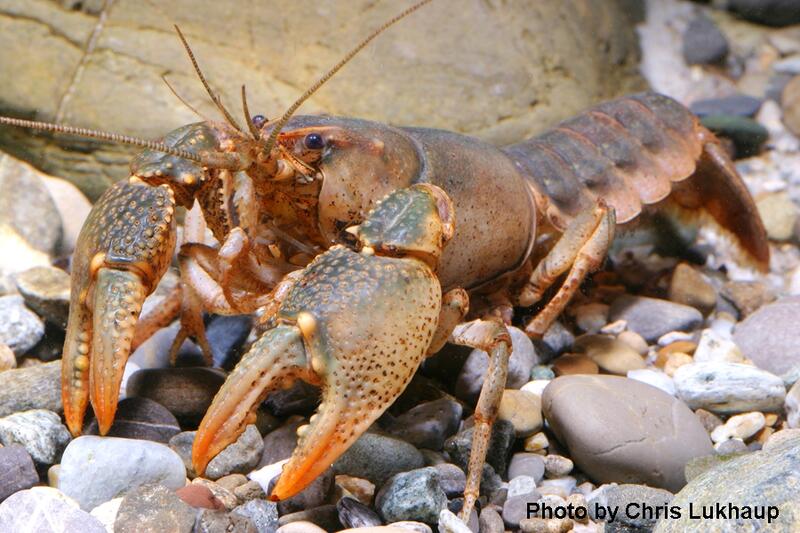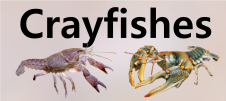







Loading profile. Please wait . . .
Lacunicambarus acanthura (Hobbs, 1981)
Thornytail Crayfish




Federal Protection: No US federal protection
State Protection: No Georgia state protection
Global Rank: G4G5
State Rank: S3S4
Element Locations Tracked in Biotics: No
SWAP 2015 Species of Greatest Conservation Need (SGCN): No
SWAP 2025 Species of Greatest Conservation Need (SGCN): No
2025 SGCN Priority Tier: None
Element Occurrences (EOs) in Georgia: 0
Habitat Summary for element in Georgia: Complex burrows adjacent to streams and ditches, or low areas where water table is near surface of ground,
The overall color of the Thornytail Crayfish varies from a dark greenish-brown to orangish-brown. The edges of the rostrum are reddish or orangish and the tips of the claws are reddish. The cephalothorax of this species is somewhat laterally compressed. The claws of this species are fairly diagnostic; the mesial margin of the palm has at least three rows of tubercles. The areola is virtually obliterated and there is a spine that extends beyond the edge of the mesial ramus of the uropod. The Thornytail Crayfish reaches a maximum total body length of about 78 mm (3.1 in). Note: Lacunicambarus was formerly a subgenus of the genus Cambarus but was elevated to the genus level by Glon et al. (2018).
Within its range the species can be separated from all others by the combination of multiple tubercle rows (3+) along the mesial margin of the palm and the spine extending beyond the margin of the mesial ramus of the uropod.
Adults inhabit complex burrows adjacent to streams and ditches or in low areas where the water table is near the surface of the ground. Hobbs (1981) collected young Thornytail Crayfish and females carrying eggs from streams.
No studies of the Thornytail Crayfish are known and the diet of burrowing crayfishes in general is poorly understood. Crayfishes are considered opportunistic omnivores and likely feed on a variety of items, both plant and animal, living or dead. Burrowing crayfishes may forage around the mouths of their burrows, eat organisms that crawl or fall into the burrow, or eat worms that inadvertently tunnel through a burrow wall.
Burrowing crayfishes inhabit a system of tunnels that may be very complex with several openings to the surface. Openings to the tunnels are often marked by piles of dirt or mud pellets (chimneys). Depending on the soil type and moisture content, these chimneys can reach heights of 15 cm (6 inches) or more. These crayfishes are typically confined to their burrows, but a male must leave its burrow to search for females during the reproductive season. As mentioned above, they may also forage near the opening of their burrow. Active burrows with fresh soil are seen from late spring to late fall, particularly after rain events. During the dry part of the summer, burrow openings may be plugged to help conserve moisture in the burrow. Reproduction probably occurs during the spring and fall, but males in reproductive condition may be found at any time during the year. It is rare to find more than one adult crayfish in the same burrow. When a female crayfish releases her eggs, she attaches them to her swimmerets and is said to be “in berry.” Upon hatching, the juvenile crayfish are attached to the mother by a thread. After the juveniles molt for the second time, they are free of the mother, but stay close and will hold on to her for some time. Multiple juveniles are occasionally found in a single burrow. Eventually they move off on their own. Crayfishes molt 6 or 7 times during their first year of life and most are probably able to reproduce by the end of that year. They molt once or twice a year for the remainder of their lives. Although it is difficult to study burrowing crayfishes, some researchers believe they may live as long as 10 years. Male Thornytail Crayfish in breeding condition have been collected in April and May in Georgia and in June in Tennessee. Females carrying eggs were found in April, and females with young were found in April and May (Hobbs 1981). The smallest male in breeding condition is about 54 mm (2.1 in) and the smallest female with eggs is about 60 mm (2.4 in) in length (Hobbs 1981).
Burrowing crayfishes may be collected by direct excavation of their burrows, by trapping, and during night surveys. Excavating burrows is time consuming and can be very difficult. It also results in destruction of the animals’ burrow. Traps made with PVC pipes or mist nets can be effective, but only when crayfishes are in an active period. Burrowing crayfishes are sometimes captured around the openings of their burrows on damp nights. It is possible to find active burrows from about mid-March to mid-November if the water table is within about 2 feet of the surface of the ground. However, most activity is seen in the spring from mid-March to mid-May and in the fall from mid-September to mid-November. Since juveniles and females with eggs or young can be found in streams, surveys targeting this species should include looking under rocks and woody debris.
In Georgia, the Thornytail Crayfish is known primarily from the northwestern portion of the state in the Coosa and Tennessee river systems. It has also been found in the Chattahoochee River system, upper Ocmulgee River system, and the Tallapoosa River system. Outside of Georgia, it is found in southeastern Tennessee and northeastern Alabama.
Activities that destroy burrows or alter hydrology in the vicinity of burrows threaten this and other burrowing species.
This species common and widespread and is apparently stable in Georgia.
Areas with burrows should be protected from land disturbing activities and activities that could alter groundwater resources. Environmental education programs should include information about burrowing crayfishes and encourage protection of burrows.
Glon, M.G., R.F. Thoma, C.A. Taylor, M. Daly, and J.V. Freudenstein. 2018. Molecular phylogenetic analysis of the devil crayfish group, with elevation of Lacunicambarus Hobbs, 1969 to generic rank and a redescription of the devil crayfish, Lacunicambarus diogenes (Girard, 1852) comb. nov. (Decapoda: Astacoidea: Cambaridae. Journal of Crustacean Biology 2018:1-14.
Hobbs, H.H., Jr. 1981. The crayfishes of Georgia. Smithsonian Contributions to Zoology 318:1–549.
Taylor, C.A., G.A. Schuster, J.E. Cooper, R.J. DiStefano, A.G. Eversole, P. Hamr, H.H. Hobbs III, H.W. Robison, C.E. Skelton, and R.F. Thoma. 2007. A reassessment of the conservation status of crayfishes of the United States and Canada after 10+ years of increased awareness. Fisheries 32:372–389.
Christopher E. Skelton
C. Skelton, August 2012: original account
C. Skelton, February 2019: general update of account.